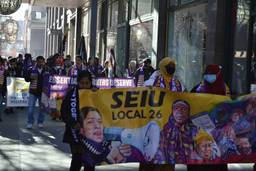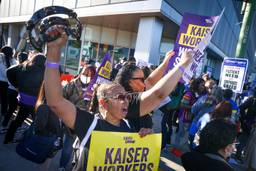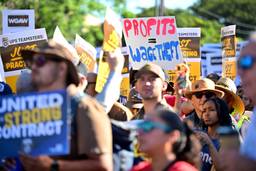The New York Times reported Monday on a striking phenomenon that is both highly disturbing and a potential boon for lawsuits regarding workplace health and safety.
The Times describes the recent rise of financial institutions financing lawsuits as a form of investment, putting up money for lawyers, experts and legal costs and collecting interest on these loans, interest that continues to accrue as legal proceedings drag on or settlements are slow in coming.
The hedge funds, banks and private investors involved in such deals spend significant effort evaluating whether a lawsuit is likely to succeed or not, since they are much more likely to collect if the lawsuit is successful. But in most cases they will be entitled to collect the loan and interest regardless.
The Times notes:
The loans are propelling large and prominent cases. Lenders including Counsel Financial, a Buffalo company financed by Citigroup, provided $35 million for the lawsuits brought by ground zero workers that were settled tentatively in June for $712.5 million. The lenders earned about $11 million.
This is similar in philosophy to the buying up of debt — whether in bundled subprime mortgages, student loans or consolidated debt — that many consider abhorrent and that has wreaked financial havoc on countless people’s lives as well as on our economy as a whole.
If taken to extremes, the concept is ripe for conspiracy theories…kind of like the practice exposed in Michael Moore’s Capitalism: A Love Story, wherein companies buy life insurance policies on their employees, often collecting much greater sums than the employees’ families themselves, sometimes long after the employee has left the company.
But an ironic twist on the investment in litigation is that lawsuits protecting workers’ rights are a prime target for such financing, meaning it could allow many such suits to go forward which wouldn’t have otherwise. When systematic abuses or unsafe conditions continue for years, lawsuits involve potentially huge settlements affecting many workers, and hence yielding significant profits for the investors that bankroll the lawsuits.
The Times features a lawsuit against a BNSF railroad tie factory in a small Texas town, where workers dealt with creosote tar and other toxic substances with little protective gear. Many developed fatal skin cancer and other serious diseases as a result. The industry has dwindled in recent years thanks to automation, so the lawsuit seemed like a boon for the now-desperately-poor town and its ailing residents.
Mr. Krueger, who is 54 but looks much older, reduced by manual labor and medical treatment, is suing the railroad for damages, claiming that BNSF failed to provide basic safety equipment or to warn workers that the federal government had linked creosote with skin cancer. He recalled cleaning the inside of the treatment tanks wearing no safety gear except steel-toed boots and mule-skin gloves.
“I got so high off that stuff I’d be laughing one minute and crying the next minute,” said Mr. Krueger, sitting at the local Dairy Queen beneath old photographs of factory workers. “I’ve got a 2-year-old grandson. My goal was to live to 101. What I’d like is a fair shake from the railroad for missing out.”
Some of the workers’ cases are going to trial one by one, and there has been no settlement. The investment firm is meanwhile charging 16 percent a year interest that must be repaid by the law firm representing the workers whether they win or lose. It is still unclear what the outcome will be, but the lawyer speculates that maybe the seemingly winnable case was not such a great investment after all.
Meanwhile, the Times notes that in addition to such massive class action or otherwise multiple-plaintiff suits, investors also favor small suits including sexual harassment cases against employers. Most workers who have been exposed to dangerous chemicals or air pollution or suffered repetitive stress or other chronic injuries on the job usually have few resources of their own to file lawsuits, and if their employer’s culpability is difficult or costly to prove they likely will have trouble finding an attorney to take on the case. Hence any source of financing that allows workers to pursue compensation for their injuries, and to create a deterrent for companies to allow unsafe or abusive conditions, has to be seen as a good thing overall.
But when the investment is 100 percent motivated by cold hard profit – with no ideological commitment to justice, workers rights or enforcing the law – we must also worry whether this will turn into another practice that basically screws over workers and regular people in the long run. The Times notes that in some cases when settlements are denied, delayed or otherwise very drawn out, the plaintiffs may end up owing more to the investor in interest than the actual award they claim. It is usually the lawyers who seek this investment, and they aren’t required to tell plaintiffs what they are doing.
It’s a sad statement that it takes such a process to seek justice for unsafe, illegal or abusive working conditions that theoretically should be prevented by laws and/or employers’ own sense of right and wrong.

I hope you found this article important. Before you leave, I want to ask you to consider supporting our work with a donation. In These Times needs readers like you to help sustain our mission. We don’t depend on—or want—corporate advertising or deep-pocketed billionaires to fund our journalism. We’re supported by you, the reader, so we can focus on covering the issues that matter most to the progressive movement without fear or compromise.
Our work isn’t hidden behind a paywall because of people like you who support our journalism. We want to keep it that way. If you value the work we do and the movements we cover, please consider donating to In These Times.
Kari Lydersen is a Chicago-based journalist, author and assistant professor at Northwestern University, where she leads the investigative specialization at the Medill School of Journalism, Media, Integrated Marketing Communications. Her books include Mayor 1%: Rahm Emanuel and the Rise of Chicago’s 99%.







